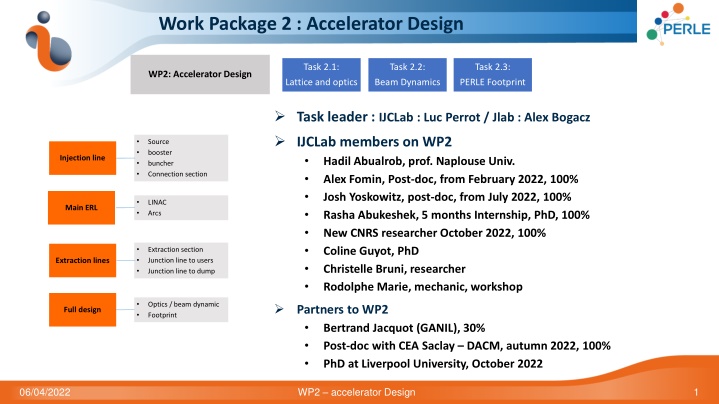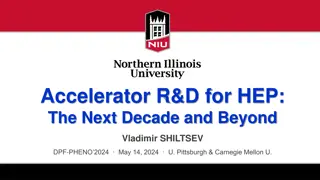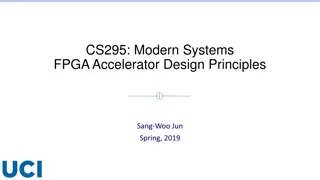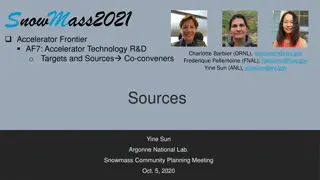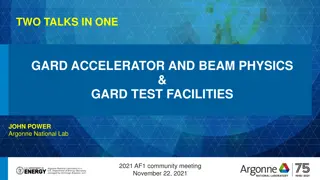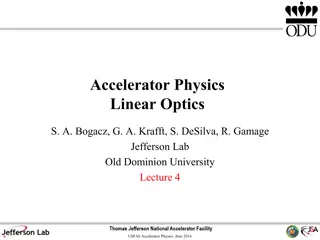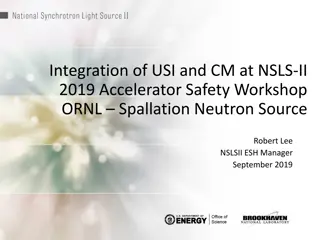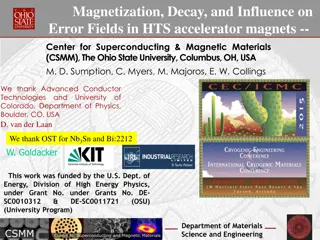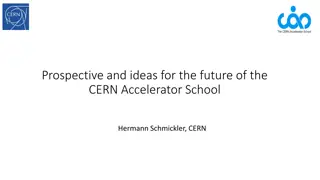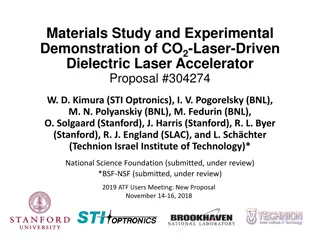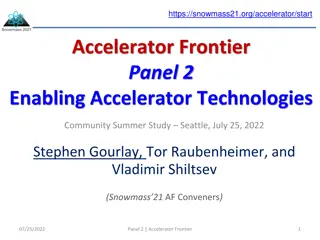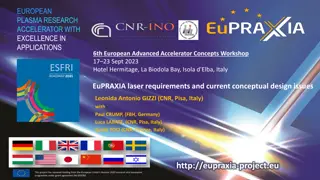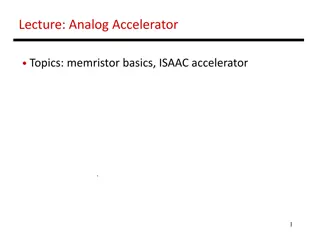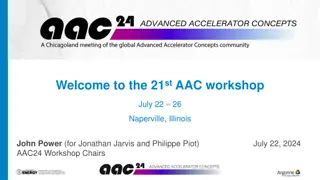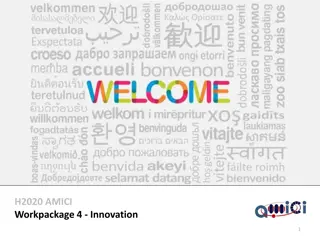Accelerator Design and DC Photogun Project Overview
This project overview outlines the tasks and goals related to Accelerator Design and DC Photogun within Work Packages 2 and 3. It includes details on team members, task leaders, activities, equipment, international collaborators, and identified contributors. Key focus areas encompass accelerator design, lattice, optics, beam dynamics, and the installation, commissioning, and testing of the ALICE photogun for the PERLE machine. Various engineers, researchers, and collaborators are involved in this project aiming to advance accelerator technology and capabilities.
Download Presentation

Please find below an Image/Link to download the presentation.
The content on the website is provided AS IS for your information and personal use only. It may not be sold, licensed, or shared on other websites without obtaining consent from the author.If you encounter any issues during the download, it is possible that the publisher has removed the file from their server.
You are allowed to download the files provided on this website for personal or commercial use, subject to the condition that they are used lawfully. All files are the property of their respective owners.
The content on the website is provided AS IS for your information and personal use only. It may not be sold, licensed, or shared on other websites without obtaining consent from the author.
E N D
Presentation Transcript
Work Package 2 : Accelerator Design Task 2.1: Lattice and optics Task 2.2: Beam Dynamics Task 2.3: PERLE Footprint WP2: Accelerator Design Task leader : IJCLab : Luc Perrot / Jlab : Alex Bogacz IJCLab members on WP2 Hadil Abualrob, prof. Naplouse Univ. Alex Fomin, Post-doc, from February 2022, 100% Josh Yoskowitz, post-doc, from July 2022, 100% Rasha Abukeshek, 5 months Internship, PhD, 100% New CNRS researcher October 2022, 100% Coline Guyot, PhD Christelle Bruni, researcher Rodolphe Marie, mechanic, workshop Source booster buncher Connection section Injection line LINAC Arcs Main ERL Extraction section Junction line to users Junction line to dump Extraction lines Optics / beam dynamic Footprint Partners to WP2 Bertrand Jacquot (GANIL), 30% Post-doc with CEA Saclay DACM, autumn 2022, 100% PhD at Liverpool University, October 2022 Full design 06/04/2022 WP2 accelerator Design 1
Work Package 2 : Accelerator Design Footprint: 29 m 5.5 m 0.9 m Very short term activities A full knowledge of the ERL design made by Alex Bogacz (Alex, Coline) Start the magnet design using OPERA (Hadil, Rasha) Ajuste the ERL optics to 250MeV (Alex, Bertrand) Interaction points (Alex, Bertrand) Injection line (Josh, following Ben Hounsell work) Final Energy [MeV] 500 Geometric Arc Radius [m] r [m] 2.75 0.62/1.24 Total Energy Loss [MeV] 6.E-03 Net Normailzed Emittance Dilution [mm mrad] 1.E-04 Net Natural Momentum Spread 5.E-06 In the perspective of the TDR : Accel design & dyn Momentum acceptance and longitudinal match Nonlinear aberrations corrections with multipole magnets Start-to-End simulation with CSR & micro-bunching Beam Break-up Instability studies Space-charge studies at injection and more Multi-particle tracking studies, error effects and halo formation Impedance analysis and wakefield effect mitigation Particle cloud 06/04/2022 WP2 accelerator Design 2
Work Package 3 : DC photogun Context: DC photogun ALICE from ERLP project (STFC Daresbury, UK) provided to IJCLab to inject the PERLE machine Goals : Install, commission and test the ALICE photogun at Orsay in preparation for injection of the PERLE machine Demonstrate high bunch charge capability (500 pC) at 40 MHz WP3: DC photogun Task 3.1: Task 3.2: Gun installation Laser system Task leaders : France : Maud Baylac (LPSC) STFC (UK): Boris Militsyn 06/04/2022 WP3 DC photogun 3
WP3 : contributors Identified contributors: 7 people from IJCLab and LPSC (Grenoble) Project System Engineer : Denis REYNET Mechanical engineer: Sylvain BRAULT (available after summer 2022) Mechanical engineer : Gregory IAQUANIELLO Mechanical engineer : Alexandre GALLAS Safety engineer : S bastien WURTH Vacuum engineer : Bruno MERCIER Optics and laser engineer : Kevin CASSOU or Daniele Nutarelli ? Electrical engineer HV power supply : Etienne LABUSSIERE LPSC + collaboration with Josh Yoskowitz, post-doc WP2, from July 2022 And support still missing for vacuum, electrical, command-control To be determined International collaborators STFC : mechancial drawings, safety file + maybe support for installation Jefferson Lab : expertise on DC photoguns Labo for photocahodes deposition : INFN ? HZDR ? To be determined 06/04/2022 WP3 DC photogun 4
WP3 : work plan Main systems required to operate the DC photogun Mechanical gun structure Modification to be implemented for interchangeable photocathodes HV power supply (350 kV) provided by UK Beamline and beam optics provided by UK SF6 infrastructures to be purchased Photocathodes + transport vessel Ultra-high vacuum pumping system (<10-10 mbar) Laser system (green light, 10 W, 10-40 MHz) Buncher to be designed and manufactured Beam diagnostics to be determined Implantation on site see presentation by Alexandre Gallas Safety application to be approved by ASN before operation of HV > 30 kV provided by UK to be purchased to be purchased to be purchased 06/04/2022 WP3 DC photogun 5
WP3 : tentative schedule Aim at producing first test beams by end of 2023 (metal photocathode, existing cathode ball) 06/04/2022 WP3 DC photogun 6
Workpackage 5 : Cryogenics WP 5 aims at: providing a cryogenic environment to: 2x cyromodules containing each 4 SRF multicell cavities, cold tuners (and ancillaries) 1x booster containing 5 SRF single cell cavities, (cold tuners and ancillaries) considering several constraints such as: working at 2 K with superfluid helium PERLE is a compact but powerfull accelerator for cryogenics: more than 500 W of heat to be removed from 2 K temperature level 06/04/2020 PERLE Collaboration Meeting Orsay 7
Workpackage Workpackage 6 : 6 : Cryogenics Cryogenics WP organization: Components/PBS: REFRIGERATOR (COLD BOX) CYCLE COMPRESSOR CRYOGENIC PURIFIER PURE GAS STORAGE GAS ANALYSER Tasks/WBS for theTDR: Definition of requirements to settle down parameters: - Collect inputs from the current developments of sub-systems for PERLE (heat loads, working press and T , press stability, operating modes ) - Collect inputs from current working machines (specifically when no data from the project is available) Conceptual design: - Analyse the different possible architectures for the whole system - Define and analyse the operating modes - Assess as much as possible the transient states (dynamic simulation might be of great help) - Include the commissioning operations in this design - Involve industry as much as possible at this stage Technical speci (almost) ready for the call for tender of the cryoplant (NB: call for tender in the design phase of PERLE) Task force: IJCLab: Patxi DUTHIL, Herv SAUGNAC, Matthieu PIERENS Partners? CRYOPLANT OIL REMOVAL SYSTEM GAS DRYER GAS STORAGE (GAS BAGS, HP STORAGE) HP COMPRESSORS PURIFICATION SYSTEM HELIUM RECOVERY, PURIFICATION AND STORAGE SYSTEM (HERECPUSS) HELIUM RECOVERY SYSTEM LIQUID STORAGE CRYOGENIC DISTRIBUTION LINES (CDL) CRYOGENIC DISTRIBUTION SYSTEM (CDS) VALVE BOXES (VBs) AUXILIARY LINES (AuxL) END BOX (EB)? TBD SENSORS PLC CONTROL AND CONTROL SYSTEM (CC) SIGNAL CONDITIONERS CABLES AND SIGNAL ROUTING E.G. POWER GENERATOR SYSTEMS BACK-UP SYSTEMS LN2 TANK LN2 suply system? TBD LN2 DISTRIBUTION SYSTEM 06/04/2020 PERLE Collaboration Meeting Orsay 8
Nouvelles du WP9 : Prvention des risques o Aspect pr vention des risques du projet pris en charge par le Service Pr vention des Risques IJCLab Inventaire et valuation des risques : les principaux L action du SPR se r partit pour l instant sur deux aspects : - Implantation du canon DC GUN dans l IGLOO - Calculs de dimensionnements de blindages radiologiques pour l acc l rateur dans le hall SUPER ACO Deux agents du service impliqu s ce stade : F. Razafimamonjy, S. Wurth Les activit s de ce WP ne peuvent se faire qu en interaction avec les autres acteurs et pour l instant en particulier avec le bureau d tude et les agents du WP DC GUN 06/04/2022 Suivi du WP9 9
Nouvelles du WP9 : Prvention des risques o Implantation du canon DC GUN dans l IGLOO (b t 209C) Il s agit d un g n rateur lectrique mettant des rayons X => instruction d un dossier aupr s de l Autorit de S ret Nucl aire Un dossier doit permettre d apporter les l ments justificatifs et documentaires n cessaires afin de garantir que l appareil est d tenu et utilis dans de bonnes conditions et d assurer la radioprotection des travailleurs et du public = coll gues Instruction du dossier avec les coll gues D finition de syst mes de s curit mettre place (interlocks) R alisation de calculs de radioprotection pour valuer les doses, valider les blindages radiologiques et d finir le zonage radiologique 06/04/2022 Suivi du WP9 10
Nouvelles du WP9 : Prvention des risques o Travail en cours D finition des points d interaction et des param tres faisceau afin de v rifier toutes les hypoth ses de fuites de rayonnements envisag es Claquage Ou perte faisceau totale ou partielle consid rer B. Militsyn, PERLE collaboration meeting, January 2022 R daction de pi ces justificatives pour le dossier ASN o La suite : poursuivre et finaliser ces calculs, constituer le dossier ASN pour un fonctionnement du canon envoyer pour 09- 10/2022 06/04/2022 Suivi du WP9 11
Nouvelles du WP9 : Prvention des risques o Pour l ensemble de la machine Nous pouvons nous appuyer sur une tude r alis e en 2018-2019 par nos coll gues de l iRSD : Ing ni rie Radioprotection S ret D mant lement (UAR 3364) Cette tude avait pour but de d finir le r gime administratif de l installation et notamment vis- -vis des crit res Installation Nucl aire de Base (INB) Les acc l rateurs d lectrons sont class s INB s ils remplissent simultan ment les deux conditions : - L nergie pouvant tre communiqu e aux lectrons est sup rieure 50 MeV - La puissance correspondante du faisceau d lectrons est sup rieure 1 kW L iRSD a tudi divers sc narii et a conclu qu il n tait pas possible de d passer les deux crit res, y compris dans des conditions incidentelles o Cet important travail est poursuivre : avec l tude de pertes de faisceau en fonctionnement sans forc ment de sc nario d incident, la question du r gime administratif de l installation appara t primordiale pour la suite. 06/04/2022 Suivi du WP9 12
Nouvelles du WP9 : Prvention des risques o Calculs de dimensionnements de blindages pour l acc l rateur dans hall SUPER ACO (b t 201A) Ici aussi il faudra un dossier ASN plus cons quent concernant un acc l rateur de particules Pour l heure : besoin de conna tre les contraintes de charge au sol, calculs en cours partir d hypoth ses issues de la bibliographie pour les sc narios de fuite (dimensionnement casemate entre 1 et 2 m de b ton) et pour le dispositif destin arr ter le faisceau (E = 7 MeV, i = 20 mA), premiers calculs un dispositif d environ 5 t pour une emprise d 1 m 7 MeV/20 mA Beam dump Fuite 500 MeV/2 A Sans blindage 06/04/2022 Suivi du WP9 13
